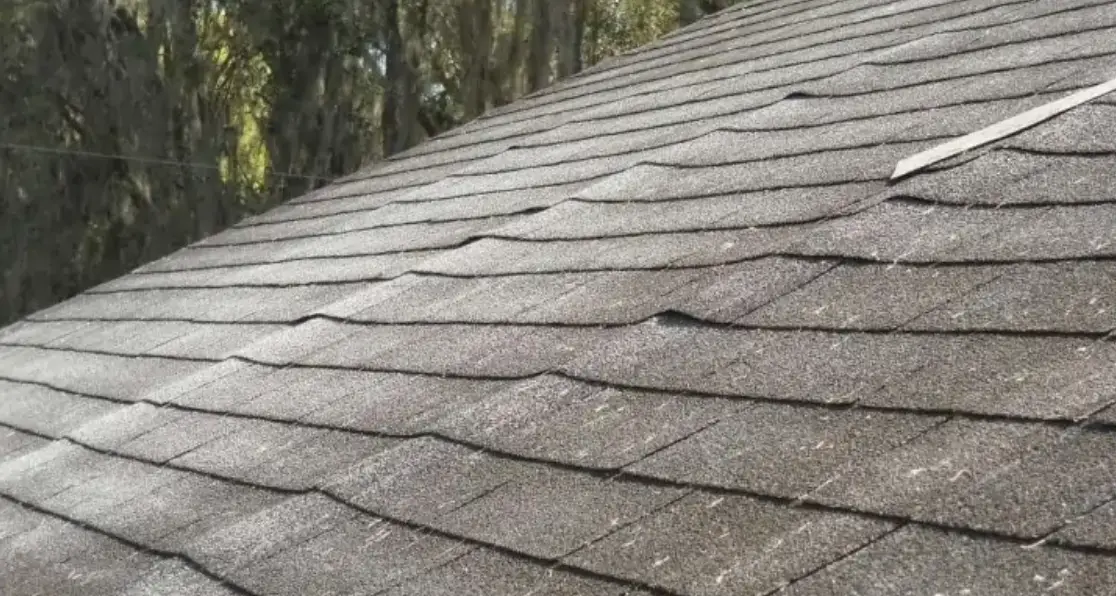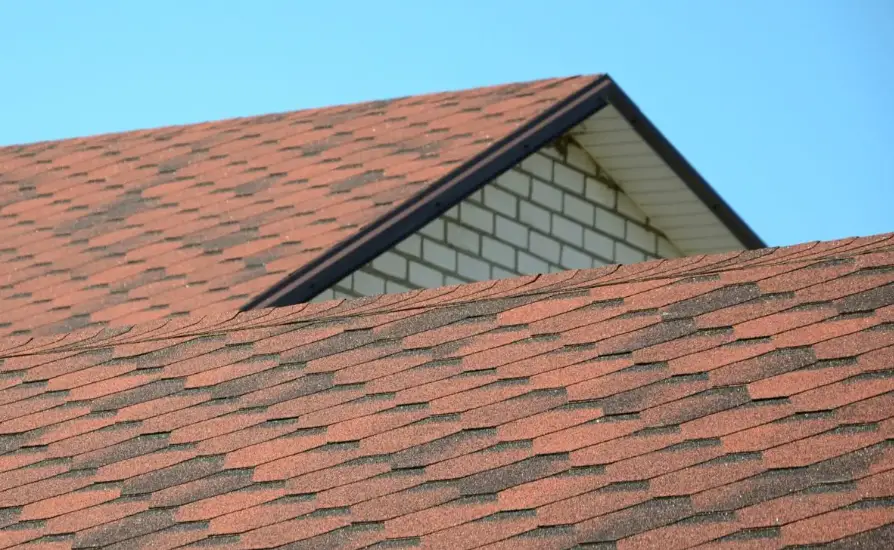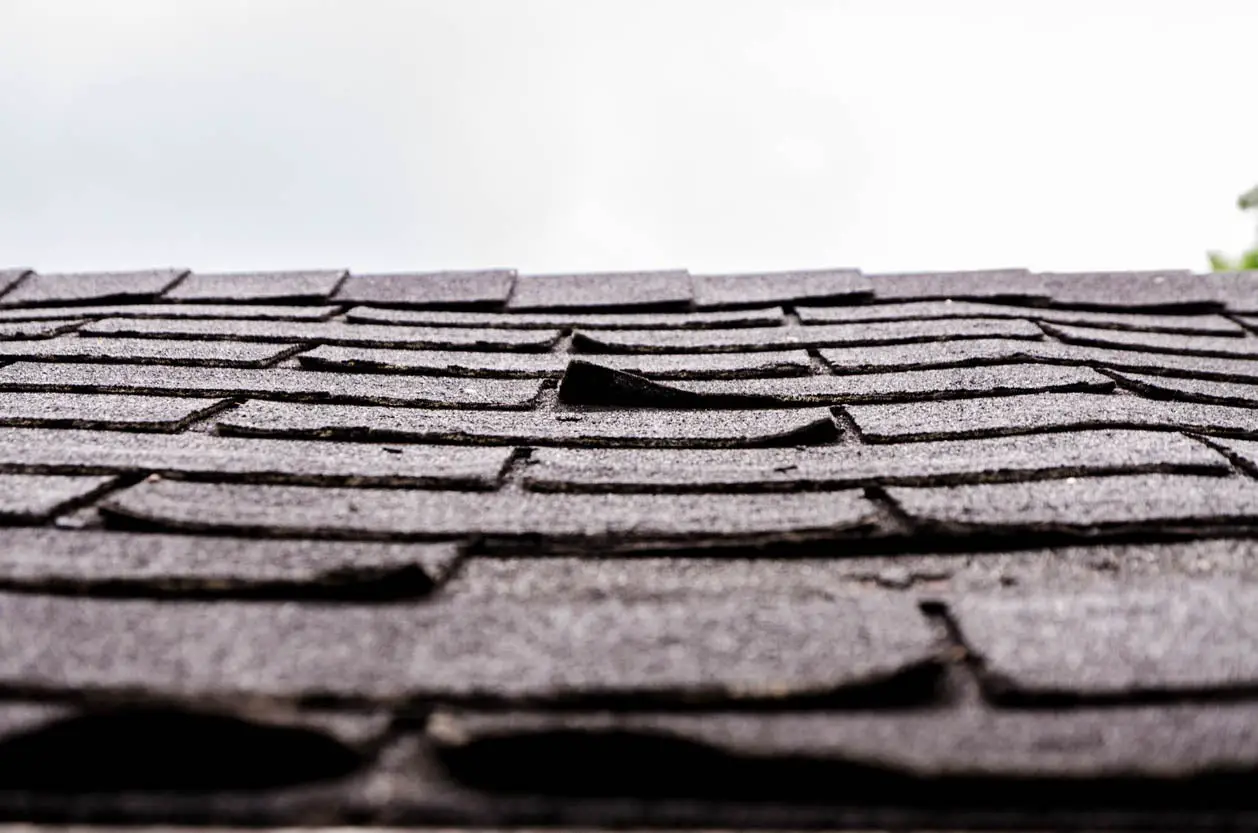A sagging roof is one of the most common problems that homeowners face. It can be caused by a variety of factors, such as improper roof installation, age, and weather damage. If left untreated, a sagging roof can lead to more serious problems, such as water damage and structural failure. In this blog post, we will discuss the causes and repair options for a sagging roof.
How Much Roof Sag Is Acceptable?

The amount of roof sag that is considered acceptable varies depending on the type of roofing material. For example, shingles are more forgiving than tile or metal roofs. Generally speaking, a sag of up to ¼ inch is tolerable. Beyond that, you’ll need to take action to avoid water damage and other problems. [1]
What Causes a Roof to Sag?
Water Damage
One of the most common causes of a sagging roof is water damage. When your roof is leaking, the water can seep into the structure of your home and cause the wood to rot. The continual weight of wet shingles can severely damage your roof and cause it to collapse. If you think you have a water leak, it’s important to call a professional right away to fix the problem.
Poorly Installed Roof
Another common cause of a sagging roof is poorly installed roofing materials. If your roof was not installed correctly, it may not be able to support the weight of the shingles and other materials.

Improper Ventilation
Another cause of a sagging roof is improper ventilation. When your attic is not properly ventilated, the heat and moisture can build up and cause the wood to warp and rot. This can lead to a serious problem because the weight of the wet shingles can cause your roof to collapse.
Excess Weight
One final cause of a sagging roof is excess weight. When there is too much weight on your roof, it can cause the structure to sag. This is often caused by things like snow and ice buildup or tree limbs falling on your roof. If you think there may be too much weight on your roof, it’s important to call a professional to have it checked out.
Bad Materials
Another possibility is that the materials used in your roof are of poor quality. If the shingles or other materials are not up to code, they may not be able to support the weight of your roof and can cause it to sag over time. Call a professional to inspect your roof if you’re not sure whether the materials are acceptable.
Age
Finally, age can also be a factor. As your roof ages, the materials can start to break down and become weaker. This can cause your roof to sag over time. If your roof is beginning to show its age, it’s time to give a call to a professional for an inspection. [2]
Signs You Might Have a Sagging Roof
One of the most obvious signs that you have a sagging roof is, well, a sag in your roof. This can be tricky to spot if you don’t know what you’re looking for, but it’s usually pretty apparent once you do. Other signs include water damage on your ceiling, cracks in your walls, and doors or windows that are suddenly difficult to open or close. If you notice any of these things, it’s time to call a professional to take a look at your roof.

How to Repair a Sagging Roof?
Roof replacement
It is the best way to fix a sagging roof. This will ensure that your home is well-protected from the elements and will also improve its curb appeal. If you are not ready to replace your entire roof, there are some things you can do to temporarily fix a sagging roof.
Roof repairs
If you have a small sag in your roof, you may be able to fix it with some roofing cement and flashing. For bigger sags, you will need to replace the damaged rafters or trusses. This is a job for a professional and should not be attempted by a novice.
Reinforcing the attic
If your home has an unfinished attic, reinforcing the floor joists is a good way to prevent further damage to your roof. This can be done by installing additional support beams or increasing the size of the existing ones. If your attic is finished, you will need to remove the drywall or paneling first before you can reinforce the floor joists. [3]
What Happens If I Leave My Sagging Roof Alone?
If you ignore a sagging roof, it will only get worse. The weight of the shingles and other materials will continue to put pressure on the rafters or trusses, causing them to sag even more.

How to Prevent a Sagging Roof?
The best way to prevent a sagging roof is to have it regularly inspected by a qualified roofing contractor. They will be able to identify any potential problems and recommend the best course of action.
Another way to prevent a sagging roof is to make sure that your gutters are clean and free of debris. Clogged gutters can cause water to back up and pool on your roof, which can lead to the formation of ice dams and eventually, a sagging roof. [4]
How Much Does It Cost to Fix a Sagging Roof?
The cost of repairing a sagging roof can vary depending on the extent of the damage and the type of repair needed. Minor repairs, such as shoring up support beams or adding reinforcement to trusses, may only cost a few hundred dollars. More extensive repairs, such as replacing damaged rafters or trusses, can cost several thousand dollars. If your home has significant damage from a sagging roof, you may need to replace the entire roof, which can cost tens of thousands of dollars.
How Many Years Does a Roof Last?
The average lifespan of a roof is 20-25 years. However, many factors can affect the lifespan of your roof and cause it to sag prematurely. Some of the most common causes of a sagging roof are:
- Improper installation
- Poor ventilation
- Excessive weight on the roof (from snow or ice)
- Leaks. [5]
Can You Put a New Roof Over the Old One?
If you have an old roof that’s sagging, you may be wondering if you can simply put a new roof over the old one. The answer is maybe, but it depends on the condition of your existing roof and whether or not it can support the weight of a new roof. If your old roof is in good condition, then putting a new roof over the old one is usually fine.
However, if your old roof is in poor condition, then it’s best to replace it entirely.
Otherwise, you run the risk of your new roof collapsing under the weight of the additional layers.
Another option for repairing a sagging roof is to add additional supports to reinforce the existing structure. This option is often used when there are only a few weak spots in the roof. By adding supports, you can help to distribute the weight of the roof more evenly and prevent further sagging.
FAQ
Can you fix a sagging roof?
The short answer is yes, a sagging roof can be fixed. However, the extent of the repair will depend on the cause of the sag. In some cases, simply adding support to the rafters may do the trick. More serious issues may require replacing sections of your roof.
What causes a sagging roof?
There are several possible causes for a sagging roof. One common cause is inadequate support for the rafters. This can be due to incorrect sizing or spacing of the rafters when the house was first built, or it could be because the supports have become weakened over time. Another possible cause is damage to the structure of your roof, which can happen due to weather conditions or age.
How can you tell if your roof is sagging?
There are a few tell-tale signs that your roof may be sagging. One is visible sagging, or dips, in the roofline. Another is cracks in the exterior walls of your home, near the eaves. If you notice any of these signs, it’s important to have a professional inspect your roof as soon as possible to determine the cause and make repairs.If you think your roof may be sagging, it’s important to have a professional inspection done as soon as possible. Sagging roofs can lead to serious structural damage to your home if left unchecked.
How much ceiling sag is acceptable?
There are a few things to consider when determining how much ceiling sag is acceptable. The first is the age of your home. Older homes are more likely to have some degree of sag, simply due to the fact that they’ve been around longer and may not have received proper maintenance over the years. However, if you have a newer home, even a small amount of sag can indicate a problem.
The second thing to consider is the type of material your roof is made out of. For example, asphalt shingles tend to be more prone to sagging than tile or metal roofs. This is because asphalt shingles are heavier and therefore put more strain on your roof’s structure. If you have an asphalt shingle roof, you’ll want to be especially vigilant about checking for sag.
Will a sagging roof collapse?
This is a common question we get here at our office. The answer is usually no, but there are some conditions that could lead to a collapse. A sagging roof is often caused by one or more of the following:
- Missing or damaged shingles
- Damaged flashing
- Ice dams
- Poorly installed gutters
If you think your roof may be in danger of collapsing, it’s important to have it inspected by a professional as soon as possible. They will be able to assess the damage and recommend the best course of action. In most cases, a sagging roof can be repaired without needing to replace the entire structure. However, if the damage is severe enough, it may be necessary to replace the roof entirely.
How do you raise a sagging ceiling?
There are a few ways that you can raise a sagging ceiling, but the most common and effective method is to use jacks. Jacks are designed to support the weight of your ceiling and will slowly raise it back into place. You can find these at most hardware stores.
Another way to raise a sagging ceiling is to remove some of the material from the bottom of the joists. This will provide more clearance for the jacks and make it easier to raise the ceiling.
Once you have raised the ceiling, you need to take steps to prevent it from happening again in the future.
How do you know if your ceiling is about to collapse?
If you see cracks or sagging in your ceiling, it’s time to take action. It’s important to have it inspected by a professional as soon as possible. They will be able to identify the cause of the problem and recommend the best course of action. In some cases, the damage may be minor and can be repaired easily. However, if the problem is more severe, you may need to replace the entire roof.
What are the signs of roof truss failure?
There are several signs that indicate roof truss failure. The most obvious sign is a sagging roof. This can be caused by many different factors, including:
- Water damage: When water leaks into the attic or upper floors of the house, it can cause the wood to rot and weaken over time. This can eventually lead to the collapse of the roof trusses.
- Poor construction: If the roof trusses are not properly constructed, they can become weakened and eventually collapse.
- Age: As a house ages, the weight of the shingles and other materials on the roof can cause the trusses to sag.
In some cases, this may only be cosmetic damage; however, in other cases, it can lead to the collapse of the roof. If you see any signs of a sagging roof, it is important to have it inspected by a professional as soon as possible.
There are several options available for repairing a sagging roof. The most common option is to reinforce the trusses with steel cables or plates. This will help to prevent further damage and collapse. In some cases, it may also be necessary to replace some of the damaged trusses. If the damage is severe, it may be necessary to completely rebuild the roof. If you are concerned about a sagging roof, contact a professional for an inspection and repair estimate. It is important to address this issue as soon as possible to avoid further damage to your home.
Can a roof collapse from rain?
A roof can collapse from rain if the rain is heavy enough and there is nowhere for the water to drain. The weight of the water can cause the roof to cave in. If you think your roof might be at risk of collapsing, it’s important to have it inspected by a professional as soon as possible.
Useful Video: Sagging Roof Fix
Conclusion
A sagging roof can be a serious problem that needs to be addressed as soon as possible. There are several different causes of a sagging roof, but the most common is structural damage. If you suspect that your roof is sagging, you should have it inspected by a professional immediately. Depending on the severity of the problem, there are several different repair options available. With prompt attention and proper repairs, you can fix a sagging roof and prevent further damage to your home.
Thank you for reading!
References
- https://www.findlayroofing.com/news/what-does-sagging-roof-indicate-everything-need-to-know
- https://www.carneyroofing.com/blog/roofing/sagging-roofs-what-causes-it-how-to-deal-with-it/
- https://legacyusa.com/article/fix-sagging-roof/
- https://www.homereference.net/sagging-roof/
- https://www.superstormrestoration.com/blog/how-long-does-a-roof-last-warning-signs-you-need-a-new-roof














Leave a Reply